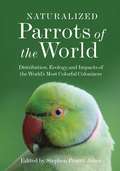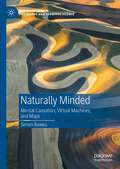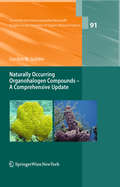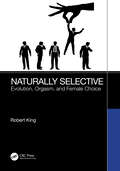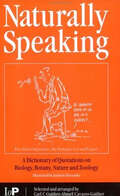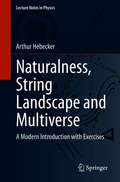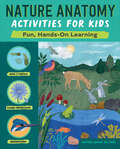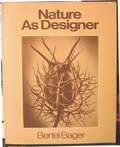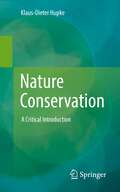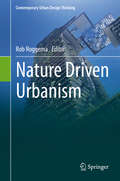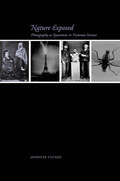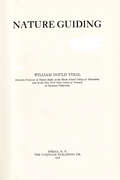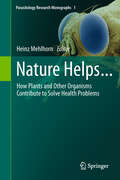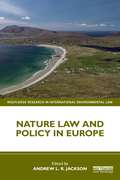- Table View
- List View
Naturalized Parrots of the World: Distribution, Ecology, and Impacts of the World's Most Colorful Colonizers
by Stephen Pruett-JonesA remarkable exploration of naturalized parrots, among the most widely distributed birds in the worldThere are more than 350 species of parrots in the world, and approximately 300 of these species have been transported to other countries through the caged pet trade. Whether through escaped captivity or purposeful release, many of these parrots are now breeding in new habitats. Indeed, no less than 75 species of parrots have established breeding populations in countries where they were introduced, and parrots are now among the most widely distributed group of birds. Naturalized Parrots of the World is the first book to examine this specific avian population.Bringing together the work of leading researchers in one convenient volume, this book explores the biology of naturalized parrots and their interactions with native ecosystems. Experts discuss the global distribution of parrots, their genetics, conservation implications, and human responses to these birds. They also consider debates surrounding management issues and the lack of consensus around nonnative species in the wild. Later chapters feature case studies of the two most successful species—the Rose-ringed Parakeet and Monk Parakeet—as well as studies of the introduced parrot species located in specific countries and regions, including the United States, United Kingdom, Spain, Portugal, northern Europe, South Africa, and Australia.Highlighting critical aspects of conservation biology and biodiversity, Naturalized Parrots of the World will be an invaluable resource for parrot owners, ornithologists, conservation biologists, and birdwatchers.
Naturally Based Biomaterials and Therapeutics
by Sujata K. Bhatia Veda EswarappaThis book advances biomedical innovations to address the plethora of health problems afflicting the developing world. A panoply of cultural, economic, infrastructural, and other factors prevent many interventions currently popular in the developed world from being similarly effective in the developing world. This book discusses less-traditional approaches, such as naturally based biomaterials and therapeutics, an area that has traditionally been overlooked but has also demonstrated impressive potential for health applications in recent years. This book explores precisely the kinds of applications which can enable countries like India to access more effective, inexpensive treatments while also taking more ownership of their healthcare technologies and innovations.
Naturally Challenged: Contested Perceptions and Practices in Urban Green Spaces (Cities and Nature)
by Nicola Dempsey Julian DobsonThis book aims to understand how the wellbeing benefits of urban green space (UGS) are analysed and valued and why they are interpreted and translated into action or inaction, into ‘success’ and/or ‘failure’. The provision, care and use of natural landscapes in urban settings (e.g. parks, woodland, nature reserves, riverbanks) are under-researched in academia and under-resourced in practice. Our growing knowledge of the benefits of natural urban spaces for wellbeing contrasts with asset management approaches in practice that view public green spaces as liabilities. Why is there a mismatch between what we know about urban green space and what we do in practice? What makes some UGS more ‘successful’ than others? And who decides on this measure of ‘success’ and how is this constituted? This book sets out to answer these and related questions by exploring a range of approaches to designing, planning and managing different natural landscapes in urban settings.
Naturally Minded: Mental Causation, Virtual Machines, and Maps (New Directions in Philosophy and Cognitive Science)
by Simon BowesThis book is an empirically informed investigation of the philosophical problem of mental causation, and a philosophical investigation of the status of cognitive scientific generalisations. If there are mental causes which can be classified in a way useful for predicting and explaining, then they are natural kinds. First. we develop an account of natural kinds that accommodates the cognitive. Second, we show how statements using these are not reducible to statements about physical kinds, involving biological and social facts. Finally, Virtual Machine Functionalism is defended as the correct account of the relationship between cognition and the material world.
Naturally Occurring Benzodiazepines, Endozepines, and their Receptors: Implications for Benzodiazepine Therapy and Withdrawal (Frontiers in Neurotherapeutics Series)
by Robert B. Raffa Diana AmanteaUnderstanding and addressing the current opioid crisis requires knowledge of endogenous opioids (endorphins and enkephalins), but there is now evidence for a benzodiazepine crisis. Are there endogenous benzodiazepine-like substances—and what do they do? How do they affect antianxiety drugs and their adverse effects? Do they explain enigmatic prolonged benzodiazepine withdrawal syndrome? This book raises important questions about the clinical consequences of ignoring the existence of or understanding the potential influence of endogenous benzodiazepines on the therapeutic effect of benzodiazepines, their adverse effects, and the problems of withdrawal from them and other benzodiazepine receptor agonists. FEATURES Discusses endogenous benzodiazepine-like substances—what do they do, and do they affect antianxiety drugs and their adverse effects? Presents information on enigmatic prolonged benzodiazepine withdrawal syndrome Describes the compounds acting at the BDZ binding sites, both exogenous (classical BDZ drugs and BDZ from food and plants) and endogenous (endozepines) Assesses the putative interactions in physiology, pathology, and pharmacology of the compounds acting at the BDZ binding sites Dr. Raffa is Adjunct Professor at the University of Arizona College of Pharmacy and Professor Emeritus at Temple University School of Pharmacy. He has co-authored or edited several books on pharmacology and thermodynamics, is a co-editor of two journals, is a past president of the Mid-Atlantic Pharmacology Society, and is the recipient of research and teaching awards. Dr. Amantea is Associate Professor of Pharmacology at the Department of Pharmacy, Health and Nutritional Sciences of the University of Calabria (Italy), where she is the leader of the Stroke Research Unit at the Section of Preclinical and Translational Pharmacology operating in the frame of the Italian Stroke Organization (ISO) Basic Science. She is a member of the Editorial Board and the Guest Editor of the 2016 Neuroscience section of Current Opinion in Pharmacology (Elsevier), and the founder and the editor of the CRC Press Frontiers in Neurotherapeutics series.
Naturally Occurring Organohalogen Compounds (Progress in the Chemistry of Organic Natural Products #121)
by A. Douglas Kinghorn Heinz Falk Simon Gibbons Yoshinori Asakawa Ji-Kai Liu Verena M. DirschThe present volume is the third in a trilogy that documents naturally occurring organohalogen compounds, bringing the total number — from fewer than 25 in 1968 — to approximately 8,000 compounds to date. Nearly all of these natural products contain chlorine or bromine, with a few containing iodine and, fewer still, fluorine. Produced by ubiquitous marine (algae, sponges, corals, bryozoa, nudibranchs, fungi, bacteria) and terrestrial organisms (plants, fungi, bacteria, insects, higher animals) and universal abiotic processes (volcanos, forest fires, geothermal events), organohalogens pervade the global ecosystem. Newly identified extraterrestrial sources are also documented. In addition to chemical structures, biological activity, biohalogenation, biodegradation, natural function, and future outlook are presented.
Naturally Occurring Organohalogen Compounds - A Comprehensive Update
by Gordon W. GribbleDespite the long association of organohalogen compounds with human activities, nature is the producer of nearly 5,000 halogen-containing chemicals. Once dismissed as accidents of nature or isolation artifacts, organohalogen compounds represent an important and ever growing class of natural products, in many cases exhibiting exceptional biological activity. Since the last comprehensive review in 1996 (Vol. 68, this series), there have been discovered an additional 2,500 organochlorine, organobromine, and other organohalogen compounds. These natural organohalogens are biosynthesized by bacteria, fungi, lichen, plants, marine organisms of all types, insects, and higher animals including humans. These compounds are also formed abiogenically, as in volcanoes, forest fires, and other geothermal events.In some instances, natural organohalogens are precisely the same chemicals that man synthesizes for industrial use, and some of the quantities of these natural chemicals far exceed the quantities emitted by man.
Naturally Occurring Phorbol Esters
by EvansThis book discusses the topic of naturally occurring phorbol esters. Chapters include; environmental hazards of diterpene esters from plants, multi-stage carcinogenesis and the biological effects of tumor promoters, review of the family euphorbiaceae, biosynthetic and chemosystematic aspects of the euphorbiacea and thymelaeaceae, non-diterpenoid constituents of euphorbiacea, macrocyclic diterpenes of the family euphorbiacea, phorbol: its esters and derivatives, the daphnane polyol esters, the ingenane polyol esters, and the biochemical mechanism of action of phorbol ester.
Naturally Occurring Radioactive Materials: Principles and Practices
by T.Rick IrvinManagement of Naturally Occurring Radioactive Materials - known in the industry as NORM -has become an important part of the regular training required for workers in oil and gas production, refinery and petrochemical manufacturing, and in certain types of mining. Proper handling of NORM-contaminated wastes and use of appropriate radiation detection and protective equipment are now understood to be important components of good worker safety programs. Until now, no practical, easy-to-read, book was available to supplement worker training courses on NORM management. Naturally Occurring Radioactive Materials: Principles and Practices fills this void by providing, in a single publication, an ideal reference for industry managers, supervisors and line personnel. The book stresses the proper handling and management of NORM contaminated wastes and provides a firm understanding of the chemical properties of radioactive agents, their toxicological effects, and the appropriate containerization and disposal methods for these materials.
Naturally Selective: Evolution, Orgasm, and Female Choice
by Robert KingResearchers of human behaviour have identified an "orgasm gap": Men usually orgasm during intercourse, whereas women often do not. This book addresses this mystery. The two leading explanations are either that women are “psychologically broken” - Freud’s theory – or badly designed – the “by-product theory.” However, there is a much more compelling third explanation. Evolutionary biology, anatomy, physiology, and direct sex research suggest women have evolved under their own selection pressures and orgasm is a fitness-increasing consequence of such selective factors. This is revealed in their patterns of orgasmic response, which are neither random nor inexplicable.Key Features• Synthesizes decades of peer-reviewed sex research in anatomy, biology, physiology, and behavior.• Engagingly written based on feedback from students, peers, and interested lay persons.• Makes sense of the “orgasm gap” between men and women.• Provides a wider context of human sexual dimorphism and mutual sexual selection.• Balances sex research and real-world research and practical applications.
Naturally Speaking: A Dictionary of Quotations on Biology, Botany, Nature and Zoology, Second Edition
by C.C. Gaither Alma E Cavazos-GaitherIn these days of ever-increasing specialization, it is important to gain a broad appreciation of the subject. With this in mind, Naturally Speaking: A Dictionary of Quotations on Biology, Botany, Nature and Zoology, Second Edition presents the largest compilation of published quotations on the natural world available so that readers can get a feel
Naturalness, String Landscape and Multiverse: A Modern Introduction with Exercises (Lecture Notes in Physics #979)
by Arthur HebeckerThis book presents a string-theoretic approach to new ideas in particle physics, also known as Physics Beyond the Standard Model, and to cosmology. The concept of Naturalness and its apparent violation by the low electroweak scale and the small cosmological constant is emphasized. It is shown that string theory, through its multitude of solutions, known as the landscape, offers a partial resolution to these naturalness problems as well as suggesting more speculative possibilities like that of a multiverse. The book is based on a one-semester course, as such, it has a pedagogical approach, is self-contained and includes many exercises with solutions. Notably, the basics of string theory are introduced as part of the lectures. These notes are aimed at graduate students with a solid background in quantum field theory, as well as at young researchers from theoretical particle physics to mathematical physics. This text also benefits students who are in the process of studying string theory at a deeper level. In this case, the volume serves as additional reading beyond a formal string theory course.
Nature (Merit Badge Series)
by Boy Scouts of AmericaThis book takes the reader to a world of nature to learn about Wildlife Communities, Birds, Mammals, Reptiles and Amphibians, Insects and Spiders, Fish, Mollusks and Crustaceans, Plants, Soil and Rocks.
Nature Activity Book for Little Ones: 100+ Activities for Everyday Outdoor Fun
by Samantha LewisIntroduce your little one to the wonders of nature with 100+ outdoor learning activities!Give your child all the benefits of nature with this activity book designed for children ages 2-5. Whether you&’re planning an afternoon in a local park, a day in the backyard, or a morning hike in a nature preserve, you and your child will find more than 100 ideas in these pages for observing, exploring, creating, and playing in nature.Nature Activity Book for Little Ones features: • 100+ outdoor activities for kids ages 2-5, geared toward their interests and developmental milestones—with little or no preparation required • Bonus activities for additional learning, including numbers, letters, shapes, and colors • School prep: the activities teach problem-solving, communication, and responsibility, important skills for school succes • Less screen time and more nature time together to fuel your child&’s curiosity and creativity and help them build an early connection with natureBest of all, this entertaining book provides more than a hundred ways to keep your child moving and occupied and for you to bond with your child, all in nature!
Nature All Around Us: A Guide to Urban Ecology
by Beatrix Beisner, Christian Messier, and Luc-Alain GiraldeauIt’s easy to stand in awe of a city’s impressive skyline, marveling at its buildings reaching for the clouds and its vast network of roadways and train lines crisscrossing in every direction. It can often seem like everything in a city is man-made, all concrete, steel, and glass. But even the asphalt jungle is not all asphalt—a sidewalk’s cracks are filled with nature, if we know where and how to look. To aid us in this quest is Nature All Around Us, which will help us to recognize (and look after) the natural world we traipse through in our daily lives. Nature All Around Us uses the familiar—such as summer Sundays humming with lawn mowers, gray squirrels foraging in planters, and flocks of pigeons—in order to introduce basic ecological concepts. In twenty-five short chapters organized by scale, from the home to the neighborhood to the city at large, it offers a subtle and entertaining education in ecology sure to inspire appreciation and ultimately stewardship of the environment. Various ecological concepts that any urban dweller might encounter are approachably examined, from understanding why a squirrel might act aggressively towards its neighbor to how nutrients and energy contained within a discarded apple core are recycled back into the food chain. Streaming through the work is an introduction to basic ecology, including the dangers of invasive species and the crucial role played by plants and trees in maintaining air quality. Taken as a whole, Nature All Around Us is an unprecedented field guide to the ecology of the urban environment that invites us to look at our towns, cities, and even our backyards through the eyes of an ecologist. It is an entertaining, educational, and inspiring glimpse into nature in seemingly unnatural settings, a reminder that we don’t have to trek into the wild to see nature—we just have to open our eyes.
Nature Anatomy Activities for Kids: Fun, Hands-On Learning (Anatomy Activities for Kids)
by Kristine BrownThink like a scientist and search like an explorer with this illustrated nature guide for kids ages 8 to 12Get ready to explore the sky above, the ground below, and all the plants and creatures in between! Made just for kids, this nature anatomy book teaches you about the incredible forces and living things that exist in nature.You'll dig in to tons of different topics—from naming the layers of the atmosphere to learning the parts of a flower—and try out fun activities like creating a mini cloud and raising a tadpole. As you explore the natural world around you, you'll become a real scientist by asking questions, imagining outcomes, testing your ideas, and then writing down what you discover.Nature Anatomy Activities for Kids includes:5 Subjects, 20 lessons—Dive in to different chapters for the earth, the sky, water, plants, and animals. Every chapter includes multiple lessons about the topic, with a new activity and a journal prompt for each.Journal like a scientist—Use your own blank journal to answer prompts and take notes so you can write and draw everything you observe or note any questions you want to find an answer for.Detailed illustrations—Colorful pictures and diagrams make this nature anatomy book fun to use and get kids excited about the anatomy of plants, animals, ecosystems, and landscapes.Get outside and explore with this book of nature anatomy activities that opens up a whole new world of learning.
Nature As Designer: A Botanical Art Study
by Bertel BagerFrom Foreword: "...Dr. Bertel Bager, who has written, collected and assorted the material for this book over a long period of years, is a man who has long been associated with both art and nature. In addition to his position of chief surgeon at one of the largest hospitals in Sweden, he has made the study of design and nature his avocation. He annually enjoys tours of discovery in the Swedish countryside, searching the grasses and thistles, mosses and lichens, usually finding something worth collecting and meditating upon. Not primarily interested in bright colors, he is fasxcinated by meadows at the time they hav ebeen deserted by butterflies, and by mountain forests, the realm of timeless lichens and mosses. Long after the meadow has lost its summer glory, he seeks the unappreciated - the fruits and seedpods - swaying and rustling in the autumn winds. When winter comes, he stands meditating upon the expressive play of shadows of dead plants on the snow. What Bager is seeking above all, is the beauty of form in nature. Displayed in many cabinets is his treasured collection of specimens amassed over the years, much like a gallery, showing the fascinating forms of simple things in nature and emphasizing the theme, 'Nature as Designer.' This volume is a guided tour through part of these treasures but is meant to stimulate interest in form and to please the eye, which is the primary purpose of an illustrated book." Softcover, 8 x 10 inches, 176 pages, 191 black and white photographs.
Nature Conservation: A Critical Introduction
by Klaus-Dieter HupkeMany things happen in nature reserves that are contradictory at first glance. For example, flower meadows are mown down during maintenance work, even though all the plants growing there are protected. Elsewhere, protected reed beds are burnt down in a fen or the top layer of soil is removed with bulldozers in a dune conservation area. Still other areas are to remain completely untouched by human intervention. The author Klaus-Dieter Hupke shows the different strategies of nature conservation. He also shows that nature conservation is mostly not exactly what the term says in essence: "protection of nature". On the contrary, in Central Europe nature conservation areas are predominantly the relics of old agricultural and thus cultural landscapes. Often, aesthetic aspects of a landscape section are also in the foreground when designating it as a natural monument or nature reserve. Moreover, nature conservation runs the risk of becoming a substitute action and an alibi for a still growing destruction of traditional and near-natural landscape systems in Central Europe as well as globally.The updated second edition now explicitly includes the consequences of climate change for nature conservation and has also incorporated a stronger reference to Austria as well as to the central Alpine region in some places for the relevant readers.
Nature Driven Urbanism (Contemporary Urban Design Thinking)
by Rob RoggemaThis book discusses the way that a nature-driven approach to urbanism can be applied at each of the urban scales; architectural design, urban design of neighborhoods, city planning and landscape architecture, and at the city and regional scales. At all levels nature-driven approaches to design and planning add to the quality of the built structure and furthermore to the quality of life experienced by people living in these environments. To include nature and greening to built structures is a good starting point and can add much value. The chapter authors have fiducia in giving nature a fundamental role as an integrated network in city design, or to make nature the entrance point of the design process, and base the design on the needs and qualities of nature itself. The highest existence of nature is a permanent ecosystem which endures stressors and circumstances for a prolonged period. In an urban context this is not always possible and temporality is an interesting concept explored when nature is not a permanent feature. The ecological contribution to the environment, and indirect dispersion of species, from a temporary location will, overall add biodiversity to the entire system.
Nature Exposed: Photography as Eyewitness in Victorian Science
by Jennifer TuckerIn Nature Exposed, Jennifer Tucker studies the intersecting trajectories of photography and modern science in late Victorian Britain. She examines the role of photograph as witness in scientific investigation and explores the interplay between photography and scientific authority. Almost immediately after the invention of photography in 1839, photographs were characterized as offering objective access to reality—unmediated by human agency, political ties, or philosophy. This mechanical objectivity supposedly eliminated judgment and interpretation in reporting and picturing scientific results. But photography is a labor-intensive process that allows for, and sometimes requires, manipulation. In the late nineteenth century, the nature of this new technology sparked a complex debate about scientific practices and the value of the photographic images in the production and dissemination of scientific knowledge. Recovering the controversies and commentary surrounding the early creation of scientific photography and drawing on a wide range of new sources and critical theories, Tucker establishes a greater understanding of the rich visual culture of Victorian science and alternative forms of knowledge, including psychical research.
Nature Farming and Microbial Applications
by Hiu-lian Xu Hiroshi Umemura James F. Parr JrProduce more abundant, high-quality crops with the information you'll find in this book!Recent concerns over environmental pollution and food quality degradation caused by the excessive use of chemicals have prompted scientists and policymakers to re-evaluate modern agricultural processes and search for alternatives that will aid in the production of healthy foods and the protection of our environment. Nature Farming and Microbial Applications summarizes current research in the field, highlighting unique practices such as the use of microbial inoculants and various alternatives to chemical fertilizers and pesticides. The principles of nature farming, as set forth by Japanese philosopher Mokichi Okada, must fulfill these requirements: producing safe and nutritious food that promotes good health providing economic and spiritual benefits to both producers and consumers being sustainable and easily practiced conserving and protecting the environment producing sufficient high-quality food for an expanding world populationTo this end, Nature Farming and Microbial Applications addresses issues of concern to organic farmers, including: soil fertility pest control effective microorganisms photosynthesis transpiration plant-water relations stress resistance of growing cropsThis well-referenced volume contains unique and original methods of modeling and analysis. It will be used again and again as a reference source for students and researchers.
Nature Guiding
by William Gould VinalNature Guiding is the science of inculcating nature enthusiasm, nature principles, and nature facts into the spirit of individuals. "Doing" nature-study means observing, wondering, and solving problems. It could include collecting, building, measuring, painting, planning, writing, touching, experimenting or any of a wide range of other activities. Most importantly, it allows children to be "original investigators."This book is intended as a resource for teachers and students engaged in nature study at summer camps and in schools. William Gould Vinal believed that the teacher of nature study should be "in sympathy with the simple life and the country way," that the nature study should emphasize observation of the interactions of plants and animals in their environment, and not be reduced to matters of taxonomy and anatomy. In Nature Guiding, he offers advice to camp counselors and school teachers on incorporating nature study into everyday activities, as well as suggestions for parents and others about using visits to state and national parks to teach nature lore.
Nature Helps...
by Heinz MehlhornNature helps... of course at first itself by developing measures that give bacteria, fungi, plants and animals a chance to be successful in their struggle for life. As a latecomer on Earth, Homo sapiens was gifted with some droplets of the divine spirit of recognition and thus became able to observe, to analyse and recombine skills of other living beings and to use them for his overwhelming career over the last 10,000 years. Of course fungi, plants, animals and even bacteria were primarily used by mankind as food or as lifestyle products such as beer, but soon it became clear that there was much more potential hidden in these organisms and that they could be used for other purposes, too. Extracts of plants and fungi were recognized as powerful remedies, as medicines, as insecticides or acarizides, as repellents against parasites or even as weapons, e.g. when poisonous compounds from frogs or plants were applied to arrowheads. Over the last 110 years the pharmaceutical industry has often simulated nature by analyzing complex organic substances taken from living organisms and then producing by synthesis absolutely pure compounds, which mostly consisted of only one single active substance. These products had the advantage of acting against precisely one target and thus produced fewer possible side effects than the complex plant extracts. However, the more serious side effect was that disease agents could develop resistances to pure medicinal products much more easily. Thus after 70 years of excellent prospects for chemotherapy, some dark clouds appeared and quickly gathered, so that several therapeutic remedies now no longer work. Therefore in many countries - especially in those where the pure chemotherapeutics are too expensive for the poor population - the cry "back to nature" is becoming louder and louder. This has led to an enormous increase of studies that again use natural extracts as remedies in the fight against diseases. The present book summarizes examples of promising aspects in a broad spectrum of applications and shows how extracts derived from bacteria, marine organisms, plants or even animals may help to treat infectious diseases, how such organisms may keep away parasites and pests from the bodies of plants or animals, including humans, and how they can be used directly to aid in diagnosis, promote wound healing and even to help catch criminals. These 15 chapters offer not only basic research on these different fields, but also show how useful and effective products can be developed from research.
Nature Law and Policy in Europe (Routledge Research in International Environmental Law)
by Andrew L. R. JacksonThis volume considers current and future challenges for nature law and policy in Europe. Following the Fitness Check evaluation of the Birds and Habitats Directives, in 2017 the EU adopted an Action Plan for nature, people and the economy to rapidly improve the Directives’ implementation and accelerate progress towards the EU's biodiversity targets for 2020. More recently, the EU has adopted a Biodiversity Strategy for 2030 and proposed an EU Nature Restoration Law. This book makes a timely contribution by examining the current state of play in light of recent and historical developments, as well as the post-2020 nature law and policy landscape. While evidence suggests that Natura 2000 and the Habitats and Birds Directives have delivered conservation benefits for wildlife in Europe, biodiversity loss continues apace. The book reviews the requirements for an effective international nature conservation system, with reference to the Birds and Habitats Directives. It examines regulatory regimes, current legal issues in the fields of site protection and species protection, the protection of areas outside Natura 2000, recent developments in the EU and the UK, including the implications of Brexit, agriculture and nature conservation, litigation, science and access to justice. Written by leading experts in the field, from a range of stakeholder groups, the volume draws on diverse experiences as well as providing interdisciplinary perspectives. This volume will be essential reading for students, scholars, practitioners, NGOs and policy-makers interested in European environmental policy and law, including for example lawyers, ecologists, environmental scientists, political scientists, natural resource managers, planners and civil servants.
Nature Out of Place: Biological Invasions In The Global Age
by Jason Van Driesche Roy Van DriescheThough the forests are still green and the lakes full of water, an unending stream of invasions is changing many ecosystems around the world from productive, tightly integrated webs of native species to loose assemblages of stressed native species and aggressive invaders. The earth is becoming what author David Quammen has called a "planet of weeds." Nature Out of Place brings this devastating but overlooked crisis to the forefront of public consciousness by offering a fascinating exploration of its causes and consequences, along with a thoughtful and practical consideration of what can be done about it. The father and son team of Jason and Roy Van Driesche offer a unique combination of narratives that highlight specific locations and problems along with comprehensive explanations of the underlying scientific and policy issues.Chapters examine Hawaii, where introduced feral pigs are destroying the islands' native forests; zebra mussel invasion in the rivers of Ohio; the decades-long effort to eradicate an invasive weed on the Great Plains; and a story about the restoration of both ecological and human history in an urban natural area. In-depth background chapters explain topics ranging from how ecosystems become diverse, to the characteristics of effective invaders, to procedures and policies that can help prevent future invasions. The book ends with a number of specific suggestions for ways that individuals can help reduce the impacts of invasive species, and offers resources for further information.By bringing the problem of invasive species to life for readers at all levels, Nature Out of Place will play an essential role in the vital effort to raise public awareness of this ongoing ecological crisis.
